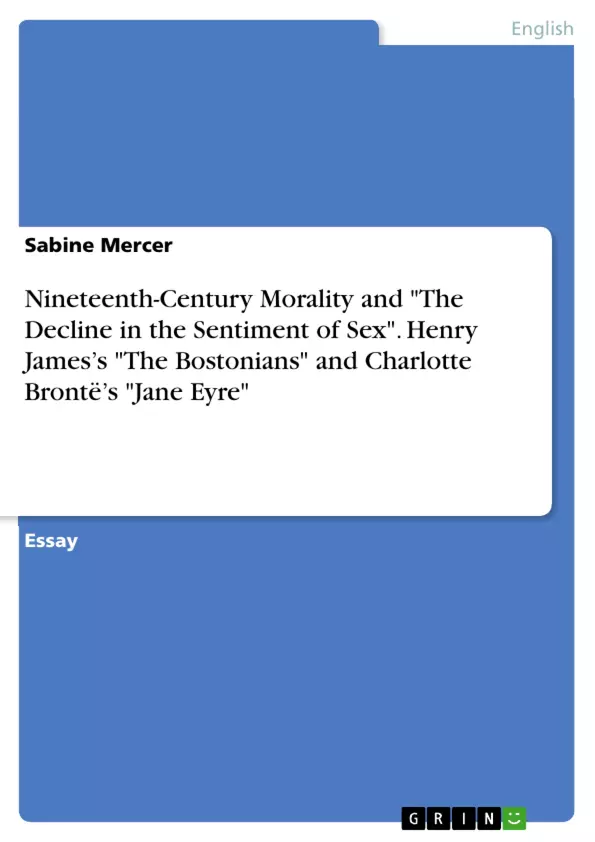The aftermath of the traumas of the American Civil War saw an unleashing of intellectual, cultural and economic forces, which accelerated the rate of transformation in American society. In post-Reconstruction America, after so much controversy about slavery, social and political reformers climbed on the platform to agitate on behalf of the Feminist movement in an “air [that] was thick with theory and controversy about women” (Habegger 9).
When Henry James outlined his general idea for "The Bostonians" (1886) in his notebook-entry of 1883, he referred to this new ideology, which he perceived as being responsible for the perversion of the confused and uprooted young American society:
I wished to write a very American tale, a tale very characteristic of our social conditions, and I asked myself what was the most salient and peculiar point in our social life. The answer was: the situation of women, the decline of the sentiment of sex, the agitation on their behalf.
The undoing of the differences between man and woman and the blurring of the boundaries between the feminine and the masculine and, in particular, the subordination of the masculine hegemony by “the stirrings of feminism in late nineteenth-century Boston” (Lansdown x) might be the root, or at least a symptom of the problem, which was upsetting both public and domestic affairs.
The novel is a drama between opposing dogmas: progressive Feminism versus conservative Chauvinism, ultimately, between the forces of progress and reaction. The analysis of the ideological conflict between these two extremes is “dramatically focused in a conflict among characters who, James said, were evolved from his ‘moral consciousness’” (McMurray 339). The notebook-entry reveals that the novel represents James’s response to a contemporary phenomenon: it seeks to investigate the situatedness of individuals in a historical context.
James's main purpose was to trace the effects of a confused system of morals in the relations between men and women and he chose to exemplify that idea by portraying a group of people in whom the essence of love had become distorted or vulgarized. The conservative James assumed that the epitome of the American problem lied in the decline of what was generally considered traditional ideals surrounding gender, which he evaluated as a potential threat to the equilibrium of forces that had previously regulated society.
Table of Contents
- Introduction to The Bostonians
- Gender Anxiety: James’s Conception of Sexual Difference
- The “Emasculated Man” and the Reign of the Feminine Voice
Objectives and Key Themes
This study examines Henry James’s The Bostonians (1886) and Charlotte Brontë’s Jane Eyre (1847) in the context of nineteenth-century morality and the changing role of women in society. It delves into the anxieties and challenges faced by both authors in a period of social and cultural upheaval.
- The impact of the Feminist movement on late nineteenth-century American society
- The shifting perception of gender roles and the blurring of traditional boundaries
- The anxieties surrounding the rise of women in professional roles, particularly in medicine
- The fear of “feminization” and the perceived decline of traditional masculinity
- The exploration of the complexities of love, marriage, and social expectations in a changing world
Chapter Summaries
The first chapter introduces the context of The Bostonians, highlighting the social and political landscape of post-Reconstruction America. It explores James’s anxieties about the changing role of women and the perceived decline of traditional gender roles. The chapter also discusses the novel’s central conflict between progressive feminism and conservative chauvinism.
The second chapter delves into James’s conception of sexual difference, examining his inherited views on the essentialist nature of masculinity and femininity. It discusses James’s portrayal of Dr. Prance, a woman doctor, and the anxieties surrounding the rise of women in professional roles. The chapter also explores the themes of emancipation and the complexities of female identity in a patriarchal society.
The third chapter examines Basil Ransom’s reactionary views on the “feminization” of American society and his fear of the decline of traditional masculinity. It explores his anxieties about women’s influence in public affairs and the perceived threat to social order. The chapter also discusses the themes of nostalgia, loss, and the struggle for power in a changing world.
Keywords
The core concepts of this study include nineteenth-century morality, gender roles, feminism, chauvinism, sexual difference, emancipation, professionalization, “feminization,” masculinity, femininity, love, marriage, and social expectations.
- Quote paper
- Dr Sabine Mercer (Author), 2005, Nineteenth-Century Morality and "The Decline in the Sentiment of Sex". Henry James’s "The Bostonians" and Charlotte Brontë’s "Jane Eyre", Munich, GRIN Verlag, https://www.grin.com/document/295212



